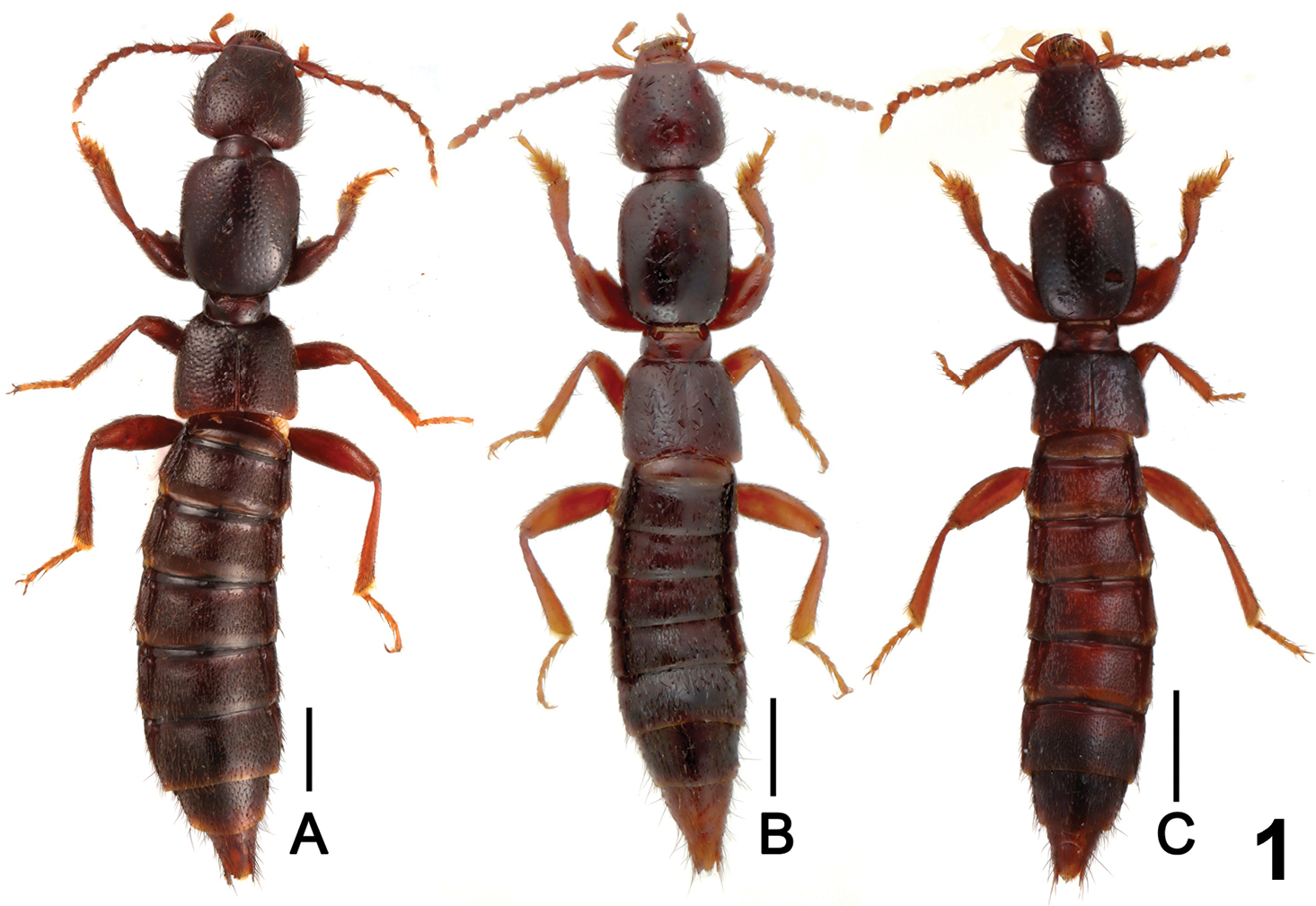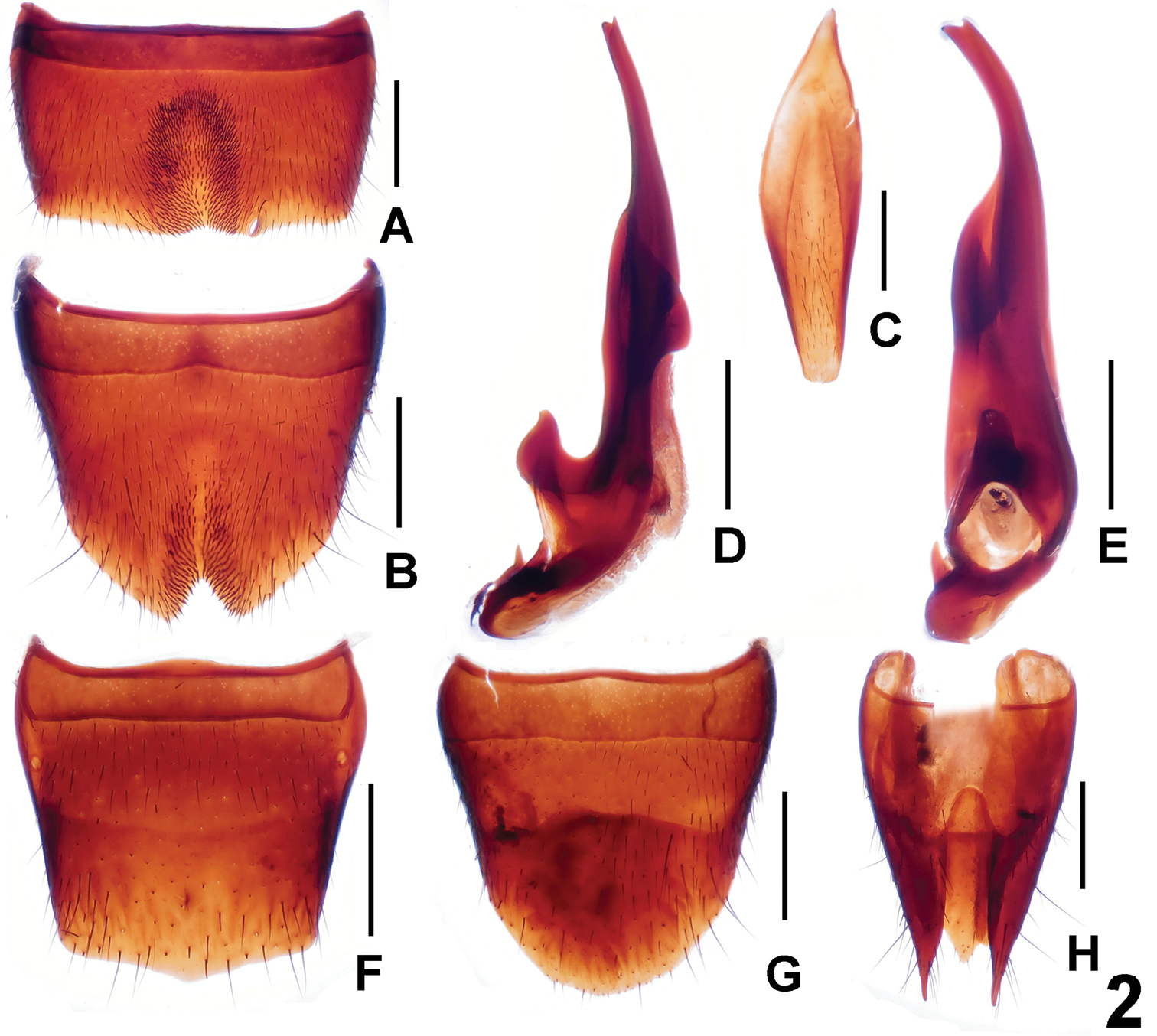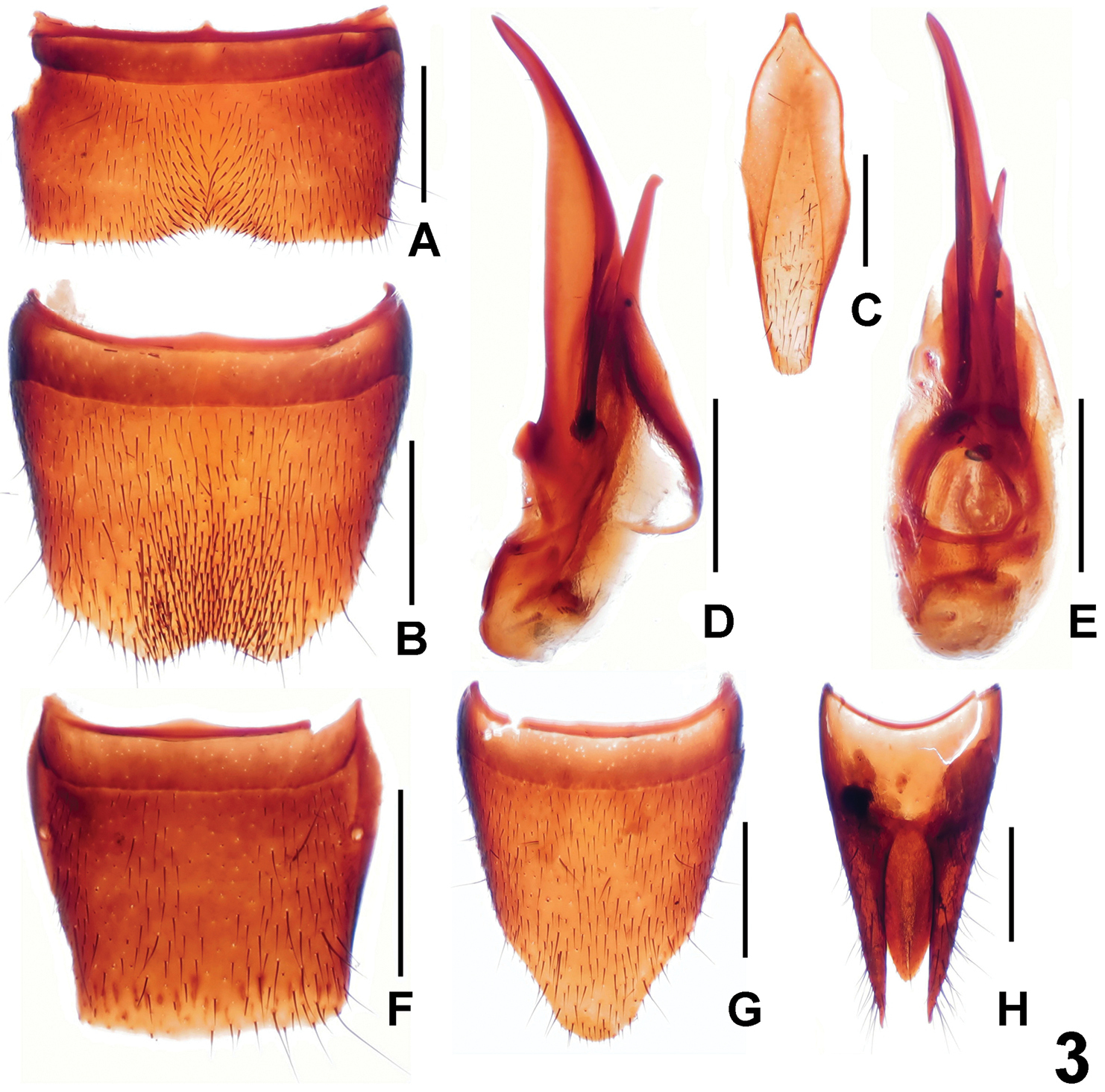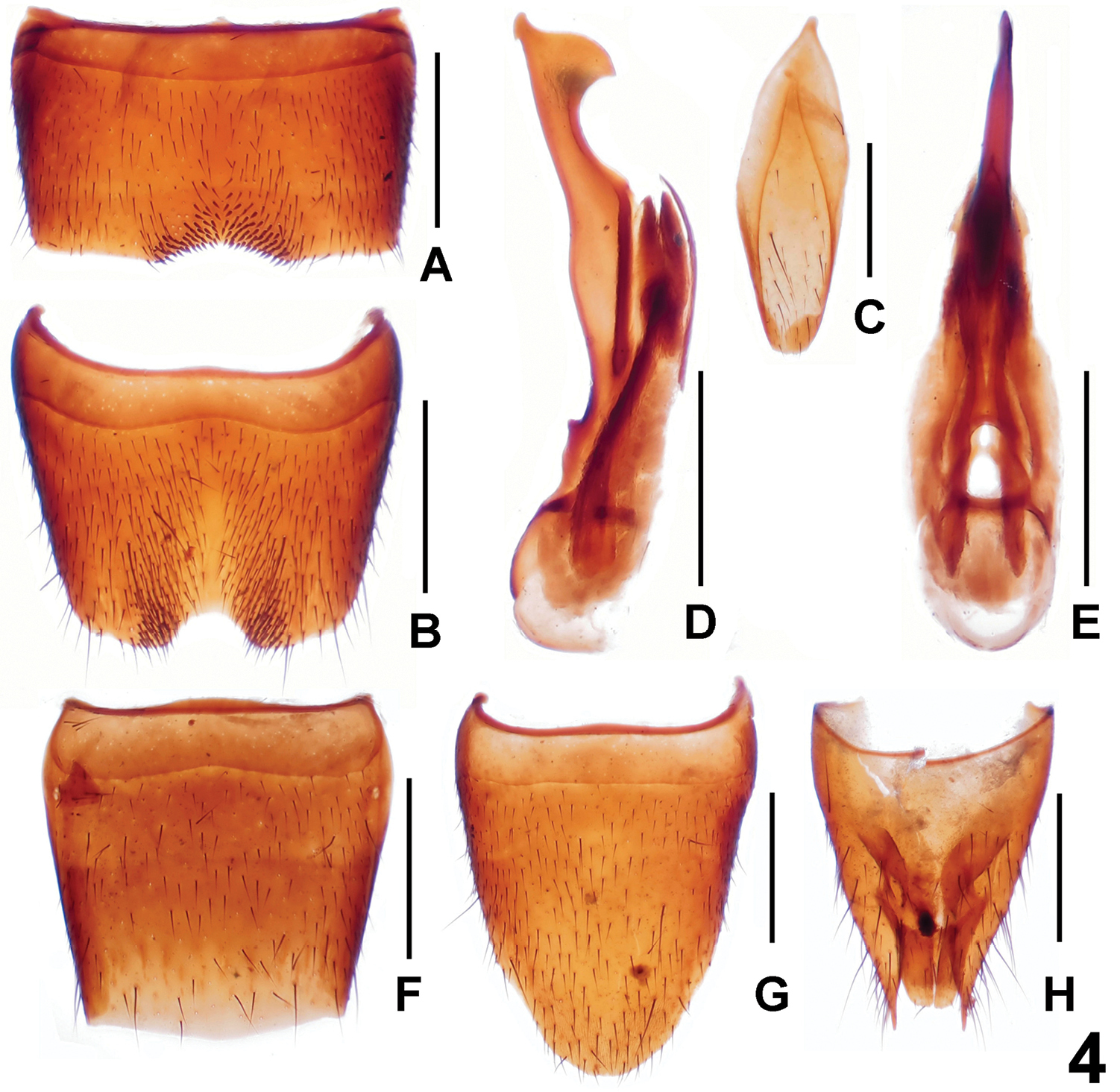






(C) 2012 Zhong Peng. This is an open access article distributed under the terms of the Creative Commons Attribution License 3.0 (CC-BY), which permits unrestricted use, distribution, and reproduction in any medium, provided the original author and source are credited.
For reference, use of the paginated PDF or printed version of this article is recommended.
Three new species of the genus Lathrobium Gravenhorst, 1802 from Sichuan Province, Southwest China are described and illustrated: Lathrobium acutissimum sp. n., Lathrobium hailuogouense sp. n. and Lathrobium labahense sp. n. A checklist of Chinese Lathrobium is provided.
Coleoptera, Staphylinidae, taxonomy, Lathrobium, new species, key to species, checklist, Sichuan, China
Up to today, 57 species of the genus Lathrobium Gravenhorst, 1802 have been reported from China. The records of four species are doubtful and the presence of the remaining 53 species has been confirmed in the past (
Only one species, Lathrobium watanabei Schülke, 2002, had been known from the vast Sichuan Province, China. In the neighbouring provinces, seventeen species have been recorded from Yunnan Province (
In 2006, Hu and Tang made a collecting trip to the Hailuogou and the Labahe natural reserves and collected a number of Lathrobium specimens. Among them, three new species are recognized and reported herein and a checklist of Chinese Lathrobium is provided.
Material and methodsAll specimens were collected from the leaf litter of in broad-leaved forests by sifting. The following abbreviations are used in the text, with all measurements in millimeters:
body length (BL): length of body from the labral anterior margin to the anal apex;
forebody length (FL): length of the clypeal anterior margin to the elytral apex;
head length (HL): length of head from the clypeal anterior margin to the posterior margin of the head;
head width (HW): maximum width of head;
pronotum length (PL): length of pronotum along midline;
pronotum width (PW): maximum width of pronotum;
elytra length (EL): length of elytra from the apex of the scutellum to the elytral posterior margin.
The type material is deposited in the Insect Collection of Shanghai Normal University, Shanghai, China. (SNUC).
Descriptionsurn:lsid:zoobank.org:act:F4955AB5-B251-496B-9802-D3D26E6D39AE
http://species-id.net/wiki/Lathrobium_acutissimum
Figs 1A , 2Labahe Natural Reserve, Sichuan Province, Southwest China
Holotype: ♂, labeled ‘CHINA: Sichuan Prov. / Tianquan County / Labahe N. R. / 30°09'N, 102°26'E / 30.vii.2006, alt. 2, 000 m / Hu & Tang leg.’. Paratypes: 4 ♂♂, 2 ♀♀, same label data as holotype; 2 ♀♀, same label data, except ‘29.v.2006’.
Measurements and ratios:BL 8.12–10.00, FL 3.78–4.11, HL 1.18–1.26, HW 1.26–1.31, PL 1.52–1.63, PW 1.30–1.41, EL 0.98–1.05, HL/HW 0.93–0.96, HW/PW 0.94–0.97, HL/PL 0.76–0.79, PL/PW 1.16–1.17, EL/PL 0.64–0.67.
Habitus as in Fig. 1A. Body brown with paler apex, legs brown to light brown, antennae brown to reddish brown.
Head subquadrate (HL/HW 0.93–0.96); punctation coarse and dense; interstices with shallow and netlike microsculpture; eyes small, approximately 1/5–1/4 of length of postocular region in dorsal view.
Pronotum nearly parallel-sided; punctation sparser than that of head; impunctate midline narrow; interstices shining without microsculpture.
Elytra with punctation denser than that of pronotum and well defined; hind wings reduced.
Abdomen with dense punctation; interstices with very shallow, transversely striate microsculpture.
Male. Sternite VII (Fig. 2A) with short, darkish setae in U-shaped posterio-median impression; sternite VIII (Fig. 2B) with triangular, symmetrical emargination and short, darkish setae in shallow impression; sternite IX (Fig. 2C) long and nearly symmetrical; aedeagus (Fig. 2D, 2E) with very slender, ventral process.
Female. Posterior margin of tergite VIII (Fig. 2F) somewhat convex; sternite VIII (Fig. 2G) slightly longer than that of male, posterior margin broadly convex; tergite X (Fig. 2H) not acute basally and not reaching anterior margin of tergite IX (Fig. 2H).
Male habitus of Lathrobium spp., A Lathrobium acutissimum B Lathrobium hailuogouense C Lathrobium labahense. Scales: 1.0 mm.
Lathrobium acutissimum. A male sternite VII B male sternite VIII C male sternite IX D aedeagus in lateral view E aedeagus in ventral view F female tergite VIIIG female sternite VIII H female tergites IX–X. Scales: 0.5 mm.
Southwest China: Sichuan.
The specific epithet (Latin, adjective: sharp) alludes to the apical margin of the male sternite IX.
It resembles Lathrobium lijiangense Watanabe & Xiao, 1997 from Yunnan in having a similar shape of the male sternite VII. The new species can be readily distinguished from these species by the male sternite VIII with a triangular emargination at the apical margin and by the aedeagus with a much longer ventral process. In Lathrobium lijiangense, the male sternite VIII has a semi-elliptical emargination at the apical margin and the ventral process of the aedeagus is short.
urn:lsid:zoobank.org:act:9D0986A3-9EFF-43D6-9414-3CD35F1F17FC
http://species-id.net/wiki/Lathrobium_hailuogouense
Figs 1B , 3Hailuogou, Sichuan Province, Southwest China
Holotype: ♂, labeled ‘CHINA: Sichuan Prov. / Luding County / Hailuogou / 29°41'N, 102°06'E / 23.vii.2006, alt. 2, 200–2, 300 m / Hu & Tang leg.’. Paratypes: 4 ♂♂, 4 ♀♀, same label data as holotype; 3 ♂♂, 4 ♀♀, same data, except ‘29°41'N, 102°07'E / 24.vii.2006, alt. 2, 800–3, 000 m’; 2 ♂♂, 4 ♀♀, same data, except ‘27.vii.2006’; 1 ♀, same data, except ‘28.vii.2006’.
Measurements and ratios:BL 7.23–8.34, FL 3.34–3.72, HL 1.04–1.11, HW 1.05–1.15, PL 1.39–1.48, PW 1.07–1.20, EL 0.93–1.02, HL/HW 0.94–0.99, HW/PW 0.96–0.99, HL/PL 0.75–0.79, PL/PW 1.23–1.30, EL/PL 0.67–0.69.
Habitus as in Fig. 1B. General appearance similar to Lathrobium acutissimum, except for somewhat smaller body size and sparser punctation on head and pronotum.
Male. Posterior margin of sternite VII (Fig. 3A) weakly concave; sternite VIII (Fig. 3B) with symmetrical, subtriangular emargination and darkish setae in large, shallow impression; sternite IX (Fig. 3C) asymmetrical; aedeagus (Fig. 3D, 3E) with slender, ventral process and short, dorsal sclerites.
Female. Posterior margin of tergite VIII (Fig. 3F) nearly truncate; sternite VIII (Fig. 3G) much longer than that of male, posterior margin strongly convex; tergite X (Fig. 3H) slender and not reaching anterior margin of tergite IX (Fig. 3H).
Lathrobium hailuogouense. A male sternite VII B male sternite VIII C male sternite IX D aedeagus in lateral view E aedeagus in ventral view F female tergite VIIIG female sternite VIII H female tergites IX–X. Scales: 0.5 mm.
Southwest China: Sichuan.
The specific epithet of this new species is derived from the type locality “Hailuogou”.
The new species resembles Lathrobium zhangi Watanabe & Xiao, 1997 from Yunnan in having the posterior margin of the male sternite VII weakly concave and a similar shape of the male sternite VIII. The new species can be readily distinguished from these species by the broad ventral process of the aedeagus in lateral view. In Lathrobium zhangi, the ventral process of the aedeagus is much narrower in lateral view.
urn:lsid:zoobank.org:act:06462E31-EB5D-4F33-849E-E224427D4CC6
http://species-id.net/wiki/Lathrobium_labahense
Figs 1C , 4Labahe Natural Reserve, Sichuan Province, Southwest China
(1 ♂, 1 ♀). Holotype: ♂, labeled ‘CHINA: Sichuan Prov. / Tianquan County / Labahe N. R. / 30°09'N, 102°28'E / 31.vii.2006, alt. 2, 400–2, 600 m / Hu & Tang leg.’. Paratypes: 1♀, same label data as holotype.
Measurements and ratios:BL 7.02–7.54, FL 2.95–3.06, HL 0.85–0.94, HW 0.88–0.92, PL 1.22–1.25, PW 0.91–0.93, EL 0.78–0.81, HL/HW 0.97–1.02, HW/PW 0.97–0.99, HL/PL 0.70–0.75, PL/PW 1.34, EL/PL 0.64–0.65.
Habitus as in Fig. 1C. Generally similar to Lathrobium acutissimum except for lighter coloration of legs, smaller body size, and somewhat sparser punctation on head and pronotum.
Male. Posterior margin of sternite VII (Fig. 4A) concave and with short, darkish setae; sternite VIII (Fig. 4B) with semicircular, symmetrical emargination and dense, long setae in shallow impression; sternite IX (Fig. 4C) nearly symmetrical; aedeagus (Fig. 4D, 4E) with long, ventral process and thin, dorsal sclerite.
Female. Posterior margin of tergite VIII (Fig. 4F) weakly convex; sternite VIII (Fig. 4G) much longer than that of male, posterior margin strongly convex; tergite IX (Fig. 4H) not separated from tergite X (Fig. 4H).
Lathrobium labahense. A male sternite VII B male sternite VIII C male sternite IX D aedeagus in lateral view E aedeagus in ventral view F female tergite VIIIG female sternite VIII H female tergites IX–X. Scales: 0.5 mm.
Southwest China: Sichuan.
The specific epithet of this new species is derived from the type locality “Labahe”.
Lathrobium labahense resembles Lathrobium watanabei Schülke, 2002 in having a similar shape of the male sternite VIII, but can be readily separated by the aedeagus with a much longer ventral process.
The checklist is presented in Table 1. The species are arranged alphabetically, and all of them belong to the nominate subgenus. For synonymies see
Lathrobium nomurai Nakane, 1955 was listed for the China in
The literature references are abbreviated as follows:
A09
A10a
A10b
Aip
B38
C05a
C05b
HE03
HU02
K46
L92
LC90
LC93
P12a
P12b
Ppp Peng et al. (present paper)
R11
S62
SCH02
SCR59
SH74
SH89
SM04
W97
W98
W99a
W99b
W05
W11
WL92
WX94
WX96
WX97
WX00
Checklist of Chinese Lathrobium. Footnotes: 1: doubtful record (likely misidentification); 2: communicated by Assing (personal communication).
| Species | Distribution in China | References |
|---|---|---|
| Lathrobium acutissimum sp. n. | Sichuan: Jiajin Shan | Ppp |
| Lathrobium ailaoshanense Watanabe & Xiao, 1997 | Yunnan: Ailao Shan | SM04, WX97 |
| Lathrobium alesi Assing, 2010 | Taiwan: Hsuehshan | A10b |
| Lathrobium alishanum Assing, 2010 | Taiwan: Alishan | A10b |
| Lathrobium anmaicum Assing, 2010 | Taiwan: Anmashan | A10b |
| Lathrobium aokii Watanabe & Xiao, 2000 | Yunnan: Diancang Shan | SM04, WX00 |
| Lathrobium baihualingense Watanabe & Xiao, 2000 | Yunnan: Gaoligong Shan | SM04, WX00 |
| Lathrobium baizuorum Watanabe & Xiao, 2000 | Yunnan: Diancang Shan | SM04, WX00 |
| Lathrobium cooteri Watanabe, 1999 | Zhejiang: Linglong Shan | SM04, W99b |
| Lathrobium cylindricum Bernhauer, 1938 | Jiangsu: Chinkiang | HU02, B38, SM04 |
| Lathrobium dabeiense Watanabe & Xiao, 1997 | Yunnan: Gaoligong Shan | SM04, WX97 |
| Lathrobium daliense Watanabe & Xiao, 1994 | Yunnan: Diancang Shan | SM04, WX94 |
| Lathrobium dignum Sharp, 1874 | Hubei, Jiangsu2, Liaoning | HU02, L92, LC93, R11, SH74, SM04 |
| Lathrobium extraculum Assing, 2010 | Taiwan: Peitawushan | A10b |
| Lathrobium follitum Assing, 2010 | Taiwan: Peitawushan | A10b |
| Lathrobium fulvipenne Gravenhorst, 1806 | Heilongjiang | SM04 |
| Lathrobium guizhouensis Chen, Li & Zhao, 2005 | Guizhou: Fanjing Shan | C05a |
| Lathrobium hailuogouense sp. n. | Sichuan: Gongga Shan | Ppp |
| Lathrobium heteromorphum Chen, Li & Zhao, 2005 | Shaanxi: Taibai Shan | C05b |
| Lathrobium houhuanicum Assing, 2010 | Taiwan: Houhuanshan | A10b |
| Lathrobium hunanense Watanabe, 2011 | Hunan: Zhangjiacao | W11 |
| Lathrobium imadatei Watanabe, 1992 | Zhejiang: Wuyanling | SM04, W92 |
| Lathrobium involutum Assing, 2010 | Taiwan: Hseuhshan | A10b |
| Lathrobium ishiianum Watanabe & Xiao, 2000 | Yunnan: Gaoligong Shan | SM04, WX00 |
| Lathrobium itohi Watanabe & Xiao, 2000 | Yunnan: Gaoligong Shan | SM04, WX00 |
| Lathrobium jingyuetanicum Li & Chen, 1990 | Jilin: Jingyuetan | L92, LC90, LC93 |
| Lathrobium jiulongshanense Peng & Li, 2012 | Zhejiang: Jiulongshan | P12b |
| Lathrobium jizushanense Watanabe & Xiao, 1997 | Yunnan: Jizu Shan | SM04, WX97 |
| Lathrobium kishimotoi Watanabe, 2011 | Hunan: Zhangjiacao | W11 |
| Lathrobium kobense Sharp, 18741 | Jilin?, Hubei? | HU02, LC93, SM04 |
| Lathrobium labahense sp. n. | Sichuan: Labahe | Ppp |
| Lathrobium lijiangense Watanabe & Xiao, 1997 | Yunnan: Yulongxue Shan | SM04, WX97 |
| Lathrobium lingae Peng, Li & Zhao, 2012 | Zhejiang: Longwangshan | P12a |
| Lathrobium lineatocolle Scriba, 18591 | Jilin? | A09, A10a, K46, LC93, SCR59, SM04 |
| Lathrobium lobrathiforme Assing, in press | Yunnan: Gaoligong Shan | Aip |
| Lathrobium lobrathioides Assing, in press | Sichuan: Jinfo Shan | Aip |
| Lathrobium longwangshanense Peng, Li & Zhao, 2012 | Zhejiang: Longwangshan | P12a |
| Lathrobium miaoershanum Watanabe, 2011 | Guangxi: Maoershan | W11 |
| Lathrobium monilicorne Sharp, 18891 | Jilin? | L92, LC93, SH89, SM04 |
| Lathrobium naxii Watanabe & Xiao, 1996 | Yunnan: Yulongxue Shan | SM04, WX96 |
| Lathrobium nenkaoicum Assing, 2010 | Taiwan: Nenkaoshan | A10b |
| Lathrobium pollens Sharp, 18891 | Jilin? | L92, LC93, SM04 |
| Lathrobium rougemonti Watanabe, 1999 | Zhejiang: West Tianmu Shan | SM04, W99 |
| Lathrobium semistriatum Scheerpeltz, 1962 | Shandong: Taishan | HU02, S62, SM04 |
| Lathrobium shaanxiensis Chen, Li & Zhao, 2005 | Shaanxi: Taibai Shan | C05b |
| Lathrobium shaolaiense Watanabe, 1998 | Taiwan: Ta-hsüeh Shan | SM04, W98 |
| Lathrobium sheni Peng & Li, 2012 | Zhejiang: Jiulongshan | P12b |
| Lathrobium shuheii Watanabe & Xiao, 2000 | Yunnan: Gaoligong Shan | SM04, WX00 |
| Lathrobium sinense Herman, 2003 | Jiangsu: Chinkiang, Yunnan? | B38, HE03, HU02, SM04, |
| Lathrobium tamurai Watanabe, 1992 | Zhejiang: Wuyanling | SM04, W92 |
| Lathrobium tarokoense Assing, 2010 | Taiwan: Taroko N. R. | A10b |
| Lathrobium tianmushanense Watanabe, 1999 | Zhejiang: West Tianmu Shan | SM04, W99 |
| Lathrobium tsuifengense Watanabe, 2005 | Taiwan: Tsuifeng | W05 |
| Lathrobium uncum Peng, Li & Zhao, 2012 | Zhejiang: Longwangshan | P12a |
| Lathrobium utriculatum Assing, 2010 | Taiwan: Peinantashan | A10b |
| Lathrobium watanabei Schülke, 2002 | Sichuan: Daxue Shan | SCH02 |
| Lathrobium xiei Watanabe & Xiao, 2000 | Yunnan: Gaoligong Shan | SM04, WX00 |
| Lathrobium yasutoshii Watanabe, 2005 | Taiwan: Lishan | W05 |
| Lathrobium yinae Watanabe & Xiao, 1997 | Yunnan: Yulongxue Shan | SM04, WX97 |
| Lathrobium yunnanum Watanabe & Xiao, 1994 | Yunnan: Laohu Shan | SM04, WX94 |
| Lathrobium zhangi Watanabe & Xiao, 1997 | Yunnan: Jizu Shan | SM04, WX97 |
| Lathrobium zhaotiexiongi Peng, Li & Zhao, 2012 | Zhejiang: Jiulongshan, Majian | P12b |
All the collectors mentioned in the text are acknowledged for their field work. Volker Assing and two anonymous reviewers are thanked for comments on a previous version of the manuscript. The study is supported by the National Natural Science Foundation of China (No. 31101659) and Shanghai Normal University (No. SK201234).



